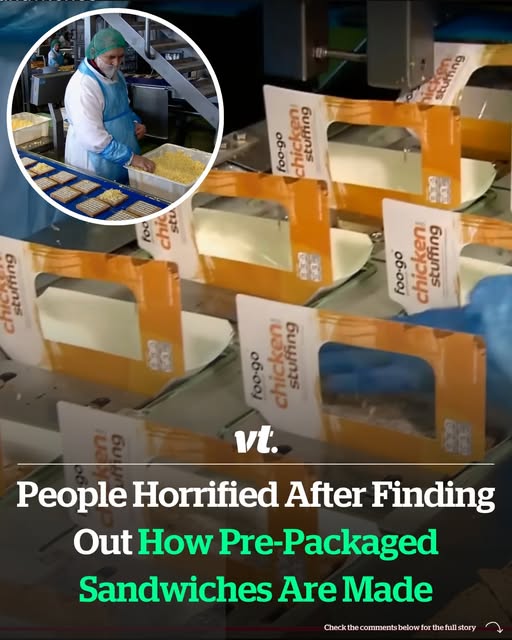People are atunned after realising how pre-packaged sandwiches, commonly found in supermarkets and convenience stores, are mass-produced. Find out more in the article below.
Assembly Line Precision Meets Human Oversight
The manufacturing process begins with fresh, pre-sliced bread loaded into automated machinery. Workers meticulously inspect each slice, discarding any with holes or imperfections. From there, the bread moves through rollers that evenly apply butter, before progressing to stations where mayonnaise and other spreads are precisely deposited using mechanical nozzles. This blend of automation and human touch ensures consistency while allowing flexibility to accommodate various sandwich types like ham & cheese or egg mayo.

Manual Touch: Filling, Assembly & Cutting
While machines handle bread and condiments, humans still manage certain key tasks. Workers, sometimes wearing gloves and sometimes not, manually add ingredients such as sliced ham, cheddar cheese, and lettuce. The sandwiches are stacked and then passed through mechanical cutters—resembling oscillating saws or ultrasonic knives—that trim designs like triangles before packaging. This combination of automation and manual labor enhances speed without sacrificing quality, but has surprised many viewers when they spotted bare hands handling the food.
Public Reaction: Between Amazement and Apprehension
The video quickly went viral on platforms like Reddit and LADbible, prompting viewers to voice strong reactions:
“My biggest take away is that the two halves in the pack aren’t from the same sandwich.”
“It’s been years since I’ve bought a premade sandwich… I can confidently say it will be many more years before I buy another.”
Comments ranged from admiration for the engineering to discomfort over food-handling practices and concerns about hygiene
Automation vs Hygiene: The Balancing Act
Full automation steps in when high-volume consistency is needed: robotic arms, suction systems, and nozzles take over filling, aligning, cutting, and packaging sandwiches—with minimal human intervention. Ultrasonic blades slice sandwiches cleanly, and suction-cup robots flip assembled products into packaging. This process underlines efforts to standardize production, reduce errors, and speed up assembly lines. However, when human hands are reintroduced in semi-automated lines, hygiene concerns arise, even when staff are garbed in hairnets and aprons.
Why It Matters to You
For consumers: Most factory-made sandwiches are assembled through a combination of human oversight and automated systems; quality and hygiene can vary. For health-conscious buyers: Watching food handled manually may be off-putting; checking labels, opt for fresh deli sandwiches, or prepare your own. For food industry insiders: These processes highlight the need for transparency, rigorous hygiene protocols, and regulatory oversight, especially in high-output environments.

Final Takeaway
The viral factory footage shows that while modern sandwich production harnesses impressive automation for efficiency, key tasks—like quality control and filling—still rely on humans. This hybrid method maintains product variety, speed, and affordability, but not without triggering consumer concerns over food safety and impersonal production. In an age where people crave both convenience and transparency, this peek into the mass-production kitchen offers a candid snapshot of industrial food making. It challenges us to rethink how our everyday meals are prepared—and perhaps inspires a return to home‑made or deli‑fresh alternatives.

















